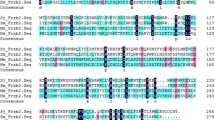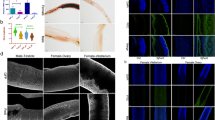Abstract
Pluripotent stem cells, called neoblasts, are well known for the regenerative capability and developmental plasticity in flatworms. Impressive advancement has been made in free-living flatworms, while in case of its parasitic counterpart, neoblast-like stem cells have attracted recent attention for its self-renewal and differentiation capacity. Nanos is a key conserved post-transcriptional regulator critical for the formation, development, and/or maintenance of the pluripotent germ line stem cell systems in many metazoans including schistosomes. In the present study, we report the molecular cloning and expression of nanos orthologous genes nanos in Schistosoma japonicum (Sjnanos). The cDNA of Sjnanos is 826 bp long, containing an open reading frame (ORF) for 223 amino acid long protein. qRT-PCR analysis shown that Sjnanos was differently expressed in several stages of schistosomes with relatively high level in schistosomula. Additionally, Sjnanos was expressed highly in adult females compared to adult males. Transfection of recombinant plasmid for expressing Sjnanos resulted in significant proliferation and increased expression of several stem cell factors in mammalian cells. Overall, our preliminary study provides the molecular basis to further functionally characterize Sjnanos in S. japonicum.





Similar content being viewed by others
References
Cioli D, Basso A, Valle C, Pica-Mattoccia L (2012) Decades down the line: the viability of praziquantel for future schistosomiasis treatment. Expert Rev Anti-Infect Ther 10(8):835–837
Collins JJ 3rd, Wang B, Lambrus BG, Tharp ME, Iyer H, Newmark PA (2013) Adult somatic stem cells in the human parasite Schistosoma mansoni. Nature 494(7438):476–479
Forbes A, Lehmann R (1998) Nanos and Pumilio have critical roles in the development and function of Drosophila germline stem cells. Development 125(4):679–690
Gobel E, Pan JP (1985) Ultrastructure of the daughter sporocyst and developing cercaria of Schistosoma japonicum in experimentally infected snails, Oncomelania hupensis hupensis. Zeitschrift fur Parasitenkunde 71(2):227–240
Gray DJ, McManus DP, Li Y, Williams GM, Bergquist R, Ross AG (2010) Schistosomiasis elimination: lessons from the past guide the future. Lancet Infect Dis 10(10):733–736
Hashimoto H et al (2010) Crystal structure of zinc-finger domain of Nanos and its functional implications. EMBO Rep 11(11):848–853
Hu M, Zhou SL, Li Y (1992) Further observation on the ultrastructure of the sporocyst of Schistosoma japonicum. Chinese Journal of Parasitology and Parasitic Diseases 10(4):301–303
Juliano CE, Swartz SZ, Wessel GM (2010) A conserved germline multipotency program. Development 137(24):4113–4126
Koprunner M, Thisse C, Thisse B, Raz E (2001) A zebrafish nanos-related gene is essential for the development of primordial germ cells. Genes Dev 15(21):2877–2885
Koziol U, Rauschendorfer T, Zanon Rodriguez L, Krohne G, Brehm K (2014) The unique stem cell system of the immortal larva of the human parasite Echinococcus multilocularis. EvoDevo 5(1):10
Kumar S, Tamura K, Nei M (2004) MEGA3: integrated software for molecular evolutionary genetics analysis and sequence alignment. Brief Bioinform 5(2):150–163
Liu N et al (2016) Functional proteomic analysis revels that the ethanol extract of Annona muricata L. induces liver cancer cell apoptosis through endoplasmic reticulum stress pathway. J Ethnopharmacol 189:210–217
Liu Q et al (2017) Function of Nanos1 gene in the development of reproductive organs of Schistosoma japonicum. Parasitol Res. doi:10.1007/s00436-017-5427-9
Livak KJ, Schmittgen TD (2001) Analysis of relative gene expression data using real-time quantitative PCR and the 2(-Delta Delta C(T)) method. Methods 25(4):402–408
Newmark PA, Sanchez Alvarado A (2000) Bromodeoxyuridine specifically labels the regenerative stem cells of planarians. Dev Biol 220(2):142–153
Pfister D et al (2008) Flatworm stem cells and the germ line: developmental and evolutionary implications of macvasa expression in Macrostomum lignano. Dev Biol 319(1):146–159
Reuter M, Kreshchenko N (2004) Flatworm asexual multiplication implicates stem cells and regeneration. Can J Zool 82(2):334–356
Schaner CE, Deshpande G, Schedl PD, Kelly WG (2003) A conserved chromatin architecture marks and maintains the restricted germ cell lineage in worms and flies. Dev Cell 5(5):747–757
Skinner DE, Rinaldi G, Suttiprapa S, Mann VH, Smircich P, Cogswell AA, Williams DL, Brindley PJ (2012) Vasa-Like DEAD-box RNA helicases of Schistosoma mansoni. PLoS Negl Trop Dis 6:e1686
Steinmann P, Keiser J, Bos R, Tanner M, Utzinger J (2006) Schistosomiasis and water resources development: systematic review, meta-analysis, and estimates of people at risk. Lancet Infect Dis 6(7):411–425
Subramaniam K, Seydoux G (1999) nos-1 and nos-2, two genes related to Drosophila nanos, regulate primordial germ cell development and survival in Caenorhabditis elegans. Development 126(21):4861–4871
Tan TC et al (2012) Telomere maintenance and telomerase activity are differentially regulated in asexual and sexual worms. Proc Natl Acad Sci U S A 109(11):4209–4214
Thompson JD, Gibson TJ, Higgins DG (2002) Multiple sequence alignment using ClustalW and ClustalX. Curr Protoc Bioinformatics. doi:10.1002/0471250953.bi0203s00 Chapter 2:Unit 2 3
Tsai IJ, Zarowiecki M, Holroyd N et al (2013) The genomes of four tapeworm species reveal adaptations to parasitism. Nature 496(7443):57–63
Tsuda M et al (2003) Conserved role of nanos proteins in germ cell development. Science 301(5637):1239–1241
Wagner DE, Wang IE, Reddien PW (2011) Clonogenic neoblasts are pluripotent adult stem cells that underlie planarian regeneration. Science 332(6031):811–816
Wagner DE, Ho JJ, Reddien PW (2012) Genetic regulators of a pluripotent adult stem cell system in planarians identified by RNAi and clonal analysis. Cell Stem Cell 10(3):299–311
Wang J, Collins JJ 3rd (2016) Identification of new markers for the Schistosoma mansoni vitelline lineage. Int J Parasitol 46(7):405–410
Wang Y, Zayas RM, Guo T, Newmark PA (2007) Nanos function is essential for development and regeneration of planarian germ cells. Proc Natl Acad Sci U S A 104(14):5901–5906
Wang Y, Stary JM, Wilhelm JE, Newmark PA (2010) A functional genomic screen in planarians identifies novel regulators of germ cell development. Genes Dev 24(18):2081–2092
Wang W, Wang L, Liang YS (2012) Susceptibility or resistance of praziquantel in human schistosomiasis: a review. Parasitol Res 111(5):1871–1877
Wang B, Collins JJ 3rd, Newmark PA (2013) Functional genomic characterization of neoblast-like stem cells in larval Schistosoma mansoni. elife 2:e00768
Wang L, Zhu H, Wu J, Li N, Hua J (2014) Characterization of embryonic stem-like cells derived from HEK293T cells through miR302/367 expression and their potentiality to differentiate into germ-like cells. Cytotechnology 66(5):729–740
Wendt GR, Collins JJ 3rd (2016) Schistosomiasis as a disease of stem cells. Curr Opin Genet Dev 40:95–102
Acknowledgements
This research was supported by National Natural Science Foundation of China (Grant No. 31472187) and the Sci & Tech Innovation Program of the Chinese Academy of Agricultural Sciences.
Author information
Authors and Affiliations
Corresponding author
Ethics declarations
All animal experiments were performed following the guidelines for animal use in toxicology with approval from the Animal Care and Use Committee of the Shanghai Veterinary Research Institute, Chinese Academy of Agricultural Sciences, Shanghai.
Rights and permissions
About this article
Cite this article
Giri, B.R., Du, X., Xia, T. et al. Molecular characterization and expression profile of nanos in Schistosoma japonicum and its influence on the expression several mammalian stem cell factors. Parasitol Res 116, 1947–1954 (2017). https://doi.org/10.1007/s00436-017-5476-0
Received:
Accepted:
Published:
Issue Date:
DOI: https://doi.org/10.1007/s00436-017-5476-0




